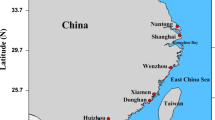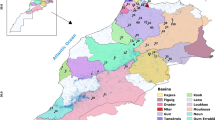Abstract
Genetic diversity and population structure in Indian featherback fish, Chitala chitala (Hamilton, 1822) was investigated by combined analyses of two full mitochondrial genes, ATPase 6/8 and Cytochrome b. A total of 403 individuals, collected from 14 rivers yielded 61 haplotypes. Hierarchical partitioning analysis identified 19.01% variance ‘among’ and 80.99% variance ‘within groups and populations’. The mean coefficient of genetic differentiation (FST) was observed to be significant 0.26 (p < 0.05). Mantel tests rejected the hypothesis that genetic and geographic distances were correlated. The patterns of genetic differentiation, AMOVA and principal coordinate analyses indicated that natural populations were sub-structured and comprised of four genetic stocks of C. chitala in Indian rivers. The results also supported the higher resolution potential of concatenated gene sequences. The knowledge of genetic variation and divergence, from this study, can be utilized for its scientific conservation and management in the wild.






Similar content being viewed by others
References
Hilton EJ, Lavoué S (2018) A review of the systematic biology of fossil and living bony-tongue fishes, Osteoglossomorpha (Actinopterygii: Teleostei). Neotropical Ichthyology 16(3):180031
Hamilton F (1822) An account of the fishes found in the river Ganges and its branches. Printed for A, Constable and company
Froese R, Pauly D (2003) Fish Base WWW Electronic Publication. World Fish. https://www.fishbase.org
Taverne L (1998) Les ostéoglossomorphes marins de l’Éocène du Monte Bolca (Italie): Monopteros Volta, 1796, Thrissopterus Heckel, 1856 et Foreyichthys Taverne, 1979. Considérations sur la phylogénie des téléostéens ostéoglossomorphes. Studi e ricerche sui giacimenti terziari di Bolca 7:67–158
Mandal A, Mohindra V, Singh RK, Punia P, Singh AK, Lal KK (2012) Mitochondrial DNA variation in natural populations of endangered Indian Feather-Back Fish. Chitala chitala. Molecular biology reports. 39(2):1765–1775
Sarkar UK, Deepak PK, Negi RS, Singh S, Kapoor D (2006) Captive breeding of endangered fish Chitala chitala (Hamilton-Buchanan) for species conservation and sustainable utilization. In Marine, Freshwater, and Wetlands Biodiversity Conservation (pp. 211–221). Springer, Dordrecht
Chaudhry S (2010) Chitala chitala. The IUCN Red List of Threatened Species 2010: e.T166510A6225101
Sarkar UK, Negi RS, Deepak PK, Lakra WS, Paul SK (2008) Biological parameters of the endangered fish Chitala chitala (Osteoglossiformes: Notopteridae) from some Indian rivers. Fish Res 90(1–3):170–177
Sarkar UK, Deepak PK, Negi RS (2009) Length–weight relationship of clown knifefish Chitala chitala (Hamilton 1822) from the River Ganga basin. India J App Ichthyol 25(2):232–233
Ward RD, Grewe PM (1994) Appraisal of molecular genetic techniques in fisheries. Rev Fish Biol Fisheries 4(3):300–325
Crandall KA, Posada D, Vasco D (1999, November) Effective population sizes: missing measures and missing concepts. In Animal Conservation forum (Vol. 2, No. 4, pp. 317–319). Cambridge University Press
Goios A, Alvarez L (2013) Mitochondrial Genetics/Evolution. In: Stanley M, Kelly H (eds) Brenner’s Encyclopedia of Genetics, 2nd edn. Elsevier, London p, pp 439–440
Gupta A, Lal KK, Mohindra V, Singh RK, Punia P, Dwivedi AK, Gupta BK, Luhariya RK, Masih P, Mishra RM, Jena JK (2013) Genetic divergence in natural populations of bronze featherback, Notopterus notopterus (Osteoglossiformes: Notopteridae) from five Indian rivers, analyzed through mtDNA ATPase6/8 regions. Meta gene 1:50–57
Singh RK, Lal KK, Mohindra V, Punia P, Sah RS, Kumar R, Gupta A, Das R, Lakra WS, Ayyappan S (2012) Genetic diversity of Indian Major Carp, Labeo calbasu (Hamilton, 1822) populations inferred from microsatellite loci. Biochem Syst Ecol 44:307–316
Xiao W, Zhang Y, Liu H (2001) Molecular Systematics of Xenocyprinae (Teleostei: Cyprinidae): Taxonomy, Biogeography, and Coevolution of a Special Group Restricted in East Asia. Mol Phylogenet Evol 18(2):163–173
Sivasundar A, Bermingham E, Ortí G (2001) Population structure and biogeography of migratory freshwater fishes (Prochilodus: Characiformes) in major South American rivers. Mol Ecol 10(2):407–417
Hall TA (1999, January) BioEdit: a user-friendly biological sequence alignment editor and analysis program for Windows 95/98/NT. In Nucleic acids symposium series (Vol. 41, No. 41, pp. 95–98). [London]: Information Retrieval Ltd., c1979-c2000
Swofford D L (2001) Paup*: Phylogenetic analysis using parsimony (and other methods) 4.0. B5
Kumar S, Stecher G, Li M, Knyaz C, Tamura K (2018) MEGA X: molecular evolutionary genetics analysis across computing platforms. Mol Biol Evol 35(6):1547–1549
Librado P, Rozas J (2009) DnaSP v5: a software for comprehensive analysis of DNA polymorphism data. Bioinformatics 25(11):1451–1452
Bandelt HJ, Forster P, Röhl A (1999) Median-joining networks for inferring intraspecific phylogenies. Mol Biol Evol 16(1):37–48
Schneider S, Excoffier L (1999) Estimation of past demographic parameters from the distribution of pairwise differences when the mutation rates vary among sites: application to human mitochondrial DNA. Genetics 152(3):1079–1089
Excoffier L, Lischer HE (2010) Arlequin suite ver 3.5: a new series of programs to perform population genetics analyses under Linux and Windows. Mole Ecol Res 10(3):564–567
Mantel N (1967) The detection of disease clustering and a generalized regression approach. Can Res 27(2):209–220
Peakall ROD, Smouse PE (2006) GENALEX 6: genetic analysis in Excel Population genetic software for teaching and research. Mol Ecol Notes 6(1):288–295
Corander J, Marttinen P, Sirén J, Tang J (2013) BAPS: Bayesian analysis of population structure. Department of Mathematics and statistics, University of Helsinki, Finland, Manual, p 6
Ray N, Currat M, Excoffier L (2003) Intra-deme molecular diversity in spatially expanding populations. Mol Biol Evol 20(1):76–86
Hobbs JPA, Van Herwerden L, Jerry DR, Jones GP, Munday PL (2013) High genetic diversity in geographically remote populations of endemic and widespread coral reef angelfishes (genus: Centropyge). Diversity 5(1):39–50
Avise JC, Neigel JE, Arnold J (1984) Demographic influences on mitochondrial DNA lineage survivorship in animal populations. J Mol Evol 20(2):99–105
Wibowo A, Affandi R, Soewardi K, Sudarto S (2017) Genetic Differentiation of the Kampar river’s Giant Featherback (Chitala lopis Bleeker 1851) Base on Mitochondrial DNA Analysis. Indonesian Fisheries Research Journal 16(2):49–58
Takagi AP, Ishikawa S, Nao T, Song SL, Hort S, Thammavong K, Saphakdy B, Phomsouvanhm A, Nishida M, Kurokura H (2010) Genetic differentiation and distribution routes of the bronze featherback Notopterus notopterus (Osteoglossiformes: Notopteridae) in Indochina. Biol J Lin Soc 101(3):575–582
Menon AGK (1951) Further studies regarding Hora’s Satpura hypothesis. The Role of Eastern Ghats in distribution of the Malayan flora and fauna to Peninsular India. Proceedings of the national Academy of Sciences. India. 17:475–497
Kim M, Morrison M, Yu Z (2011) Evaluation of different partial 16S rRNA gene sequence regions for phylogenetic analysis of microbiomes. J Microbiol Methods 84(1):81–87
Slatkin M, Hudson RR (1991) Pairwise comparisons of mitochondrial DNA sequences in stable and exponentially growing populations. Genetics 129(2):555–562
Frankham R, Ballou JD, Briscoe DA (2004) A primer of conservation genetics. Cambridge University Press, United Kingdom, p 220
Delrieu-Trottin E, Maynard J, Planes S (2014) Endemic and widespread coral reef fishes have similar mitochondrial genetic diversity. Proceedings of the Royal Society B: Biological Sciences 281(1797):20141068
Hartl DL, Clark AG, Clark AG (1997) Principles of population genetics, vol 116. Sinauer associates, Sunderland, MA
Sodsuk PK, Sodsuk, (2000) Gentic diversity of featherback fish in Thailand. Agriculture and Natural resources 34(2):227–239
Barby FF, Ráb P, Lavoué S, Ezaz T, Bertollo LAC, Kilian A, Maruyama SR, Aguiar de Oliveira E, Artoni RF, Santos MH, Ilesanmi Jegede O (2018) From chromosomes to genome: insights into the evolutionary relationships and biogeography of Old World knifefishes (Notopteridae; Osteoglossiformes). Genes 9(6):306
Daniels RR (2001) Endemic fishes of the Western Ghats and the Satpura hypothesis. Current Science-Bangalore 81(3):240–244
Chauhan T, Lal KK, Mohindra V, Singh RK, Punia P, Gopalakrishnan A, Sharma PC, Lakra WS (2007) Evaluating genetic differentiation in wild populations of the Indian major carp, Cirrhinus mrigala (Hamilton–Buchanan, 1882): evidence from allozyme and microsatellite markers. Aquaculture 269(1–4):135–149
Acharya AP, Pavan-Kumar A, Gireesh-Babu P, Joshi CG, Chaudhari A, Krishna G (2019) Population genetics of Indian giant river-catfish, Sperata seenghala (Sykes, 1839) using microsatellite markers. Aquat Living Resour 32:4
Khedkar GD, Jamdade R, Kalyankar A, Tiknaik A, Ron TB, Haymer D (2014) Genetic fragmentation in India’s third longest river system, the Narmada. Springer Plus 3(1):385
Bhandari S, Maurya DM, Chamyal LS (2005) Late Pleistocene alluvial plain sedimentation in lower Narmada Valley, Western India: palaeoenvironmental implications. J Asian Earth Sci 24(4):433–444
Briggs JC (2003) The biogeographic and tectonic history of India. J Biogeogr 30(3):381–388
Martinez AS, Willoughby JR, Christie MR (2018) Genetic diversity in fishes is influenced by habitat type and life-history variation. Ecology and Evolution 8(23):12022–12031
Chandan R, Singh RK, Singh A, Paul P, Sah RS, Kumar R, Mohindra V, Lal KK, Jena JK (2020) Spatio-temporal variations in length-weight relationship and condition factor of two notopterids, Chitala chitala (Hamilton, 1822) and Notopterus notopterus (Pallas, 1769). Indian J Fish 67(2):120–124
Verma SR, Dalela RC (1975) Studies on the Pollution of the Kalinadi by Industrial Wastes near Mansurpur Part 2: Biological Index of Pollution and Biological Characteristics of the River. Actahydrochimica et hydrobiologica 3(3):259–274
Tran NN, Thanh VC, Hirata Y (2005) Genetic diversity and conservation of the threatened freshwater Clown Knifefish Notopterus chitala through artificial propagation in the Mekong Delta. Biosphere conservation: for nature, wildlife, and humans 6(2):61–66
Vass K, Das M, Tyagi R, Katiha P, Samanta S, Srivastava N, Bhattacharjya B, Suresh V, Pathak V, Chandra G, Debnath D (2011) Strategies for sustainable fisheries in the Indian part of the Ganga-Brahmaputra river basins. International Journal of Ecology and Environmental Sciences 37(4):157–218
Acknowledgments
This work has been carried out under the project scheme of the Indian Council for Agricultural Research, India entitled, “Outreach Activity on Fish Genetic Stocks Phase-II”. The authors are thankful to Director, ICAR-National Bureau of Fish Genetic Resources, Lucknow, India for providing the facilities needed for executing this work. The authors are also grateful to Sh Pradipta Paul, Dr. L.K Tyagi, Dr. Santosh Kumar, Sh Kantharajan G, Dr. Achal Singh, and Sh Rajkumar for their help in sampling and geo-referenced riverine map preparations. Sh R.S. Sah and Sh Rajesh Kumar are thankfully acknowledged for their excellent technical assistance.
Author information
Authors and Affiliations
Corresponding author
Ethics declarations
Conflict of Interest
The authors declare that they have no conflict of interest.
Ethical approval
All applicable international, national, and/or institutional guidelines for the care and use of animals were followed. The methodologies were approved by the Institutional Animal Ethical Committee (IAEC), ICAR-NBFGR, Lucknow, India vide No. G/CPCSEA/IAEC/2015/2 dated 27 October, 2015.
Informed consent
Informed consent was obtained from all the authors who were involved in this piece of work. The manuscript is submitted after forwarding through the prescribed procedures of the institute with the approval of the competent authority.
Additional information
Publisher's Note
Springer Nature remains neutral with regard to jurisdictional claims in published maps and institutional affiliations.
Electronic supplementary material
Below is the link to the electronic supplementary material.
Rights and permissions
About this article
Cite this article
Dutta, N., Singh, R.K., Pathak, A. et al. Mitochondrial DNA markers reveal genetic connectivity among populations of Osteoglossiform fish Chitala chitala. Mol Biol Rep 47, 8579–8592 (2020). https://doi.org/10.1007/s11033-020-05901-w
Received:
Accepted:
Published:
Issue Date:
DOI: https://doi.org/10.1007/s11033-020-05901-w




